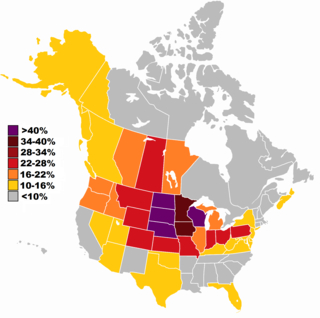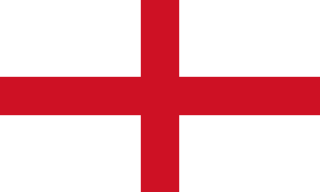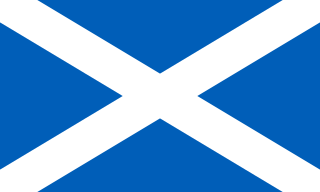Related Research Articles

Sir Robert Gordon Menzies,, was an Australian politician who twice served as Prime Minister of Australia, in office from 1939 to 1941 and again from 1949 to 1966. He played a central role in the creation of the Liberal Party of Australia, defining its policies and its broad outreach. He is Australia's longest-serving prime minister, serving over 18 years in total.
White is a racial classification and skin color specifier, generally used for people of European origin; although the definition can vary depending on context, nationality, and point of view. This term has at times been expanded to encompass persons of South Asian, West Asian, and North African descent, persons who are often considered "non-white" in other contexts in the United States. It has also been alleged that, in the United States, people of Southern European and even Irish descent have been excluded from this category, although this idea has been contested. The usage of "white people" or a "white race" for a large group of mainly or exclusively European populations, defined by their light skin, among other physical characteristics, and contrasting with "black", "red", "brown", "yellow", and other "colored" people or "persons of color", originated in the 17th century. Prior to this, Europeans also described people from East Asia as being "white". It was only during the 19th century that this vague category was transformed in a pseudo-scientific system of race and skin color relations.
A Eurasian is a person of mixed Asian and European ancestry.
Anglo-Celtic Australians are Australians whose ancestors originate wholly or partially in the countries of England, Wales, Scotland and Ireland.

The Immigration and Nationality Act of 1965, also known as the Hart–Celler Act, is a federal law passed by the 89th United States Congress and signed into law by President Lyndon B. Johnson. The law abolished the National Origins Formula, which had been the basis of U.S. immigration policy since the 1920s. The act removed de facto discrimination against Southern and Eastern Europeans, Asians, as well as other non-Northwestern European ethnic groups from American immigration policy.

Archie Galbraith Cameron was an Australian politician. He was a government minister under Joseph Lyons and Robert Menzies, leader of the Country Party from 1939 to 1940, and finally Speaker of the House of Representatives from 1950 until his death.

Anglo-Americans are people who are English-speaking inhabitants of Anglo-America. It typically refers to the nations and ethnic groups in the Americas that speak English as a native language who comprise the majority of people who speak English as a first language. This usage originated in the discussion of the history of English-speaking people of the United States and the Spanish-speaking people residing in the western United States during the Mexican–American War.

German Canadians are Canadian citizens of German ancestry or Germans who emigrated to and reside in Canada. According to the 2016 census, there are 3,322,405 Canadians with full or partial German ancestry. Some immigrants came from what is today Germany, while larger numbers came from German settlements in Eastern Europe and Imperial Russia; others came from parts of the German Confederation, Austria-Hungary and Switzerland.

Hispanic and Latino Americans are Americans of Spanish or Latin American ancestry. More generally, these demographics include all Americans who identify as Hispanic or Latino. As of 2018, the Census Bureau estimated that there were almost 60 million Hispanics living in the United States.

European exploration and settlement of Oceania began in the 16th century, starting with Portuguese settling the Moluccas and Spanish (Castilian) landings and shipwrecks in the Marianas Islands, east of the Philippines, followed by the Portuguese landing and settling temporarily in the Tanimbar or the Aru Islands and in some of the Caroline Islands and Papua New Guinea, and several Spanish landings in the Caroline Islands and New Guinea. Subsequent rivalry between European colonial powers, trade opportunities and Christian missions drove further European exploration and eventual settlement. After the 17th century Dutch landings in New Zealand and Australia, but not settling these lands, the British became the dominant colonial power in the region, establishing settler colonies in what would become Australia and New Zealand, both of which now have majority European-descended populations. New Caledonia (Caldoche), Hawaii, French Polynesia, Norfolk Island and Guam also have significant European populations. Europeans remain a primary ethnic group in much of Oceania, both numerically and economically.

Australians, colloquially referred to as "Aussies", are the citizens, nationals and individuals associated with the country of Australia.

English Australians, also known as Australians of English descent or Anglo-Australians, are Australians whose ancestry originates wholly or partly in England. In the 2016 census, 7.8 million or 36.1% of respondents identified as "English" or a combination including English and is the largest 'ancestry' self-identity in the Australian census. English Australians have more often come from the South than the North of England.
French Australians, some of whom refer to themselves as Huguenots, are Australian citizens or residents of French ancestry, or French-born people who reside in Australia. According to the 2011 Census, there were 110,399 people of French descent in Australia and 24,675 French-born people residing in the country at the time of the census, representing an increase of 28.6 percent compared to the 2006 Census. The largest French Australian community is in the state of New South Wales, where they number 8,936 people–many of them reside in Sydney.

The English people are an ethnic group and a nation native to England, who speak the English language of the Germanic language family and share a common history and culture. The English identity is of early medieval origin, when they were known in Old English as the Angelcynn. Their ethnonym is derived from the Angles, one of the Germanic peoples who migrated to Great Britain around the 5th century AD. England is the largest and most populous country of the United Kingdom of Great Britain and Northern Ireland.
American ancestry refers to people in the United States who self-identify their ancestral origin or descent as "American", rather than the more common officially recognized racial and ethnic groups that make up the bulk of the American people. The majority of these respondents are visibly White Americans, who either simply use this response as a political statement or are far removed from and no longer self-identify with their original ethnic ancestral origins. The latter response is attributed to a multitude of generational distance from ancestral lineages, and these tend be of English, Scotch-Irish, or other British ancestries, as demographers have observed that those ancestries tend to be seriously undercounted in U.S. Census Bureau American Community Survey ancestry self-reporting estimates. Although U.S. Census data indicates "American ancestry" is commonly self-reported in the Deep South and Upland South, the vast majority of Americans and expatriates do not equate their nationality with ancestry, race or ethnicity, but with citizenship and allegiance.
European Australians or White Australians are citizens or residents of Australia whose ancestry originates from the peoples of Europe. They form the largest panethnic group in the country.
Non-Hispanic whites are European Americans, Middle Eastern Americans, and North African Americans that speak English as a native language as defined by the United States Census Bureau.

The Scottish people or Scots are a nation and ethnic group native to Scotland. Historically, they emerged from an amalgamation of two Celtic-speaking peoples, the Picts and Gaels, who founded the Kingdom of Scotland in the 9th century. Pictish-Gaels were then displaced by Viking settlers to the north and west, who in turn became Norse-Gaels, and, becoming Gaelicised by the 13th century, left a Norse legacy in places such as the Hebrides.
Eastern European Canadians are Canadians of Eastern European ancestry. Eastern European Canadian people can usually trace back full or partial heritage to Russia, Ukraine, Belarus, Moldova and other nations in, bordering with, or otherwise culturally connected to Eastern Europe.
Eastern European Americans are Americans of Eastern European ancestry. Eastern European American people can usually trace back full or partial heritage to Belarus, Russia, Moldova, Ukraine and other nations connected to Eastern Europe geographically or culturally.
References
- ↑ Richard Appleton (1983). Australian Writing: Ethnic Writers 1945-1991 (Volume 1 ed.). Angus & Robertson. p. 226. ISBN 978-0959660425.
The retention, by immigrant communities, of the beliefs, values and rituals of their parent culture, whether British, Irish, Mediterranean or Eastern European. Australian Catholicism is an obvious example of this phenomenon.
- ↑ Charles Miranda (5 September 2013). "Bodies pile up in South Africa as gangs fight over lucrative Australian drug trade". The Daily Telegraph .
The AFP declined to comment about the Eastern European-Australian dual nationals working with South Africans
- ↑ Justin Peter Civitillo (2014), The role of soccer in the adjustment of immigrants to Australia: a South Australian case study 1947 to 2013., The University of Adelaide,
Eastern Europeans were the most numerous non-British settlers during early postwar intakes, comprising 37 per cent of immigration to Australia from 1947 to 1951 (CBCS, 1953);
- ↑ Malcolm David Prentis (2008). "Preface". The Scots in Australia. University of New South Wales Press. p. vii. ISBN 978-1921410215.
Scots ... adapted so successfully that they are often hard to recognise ... Furthermore, they were not bound to home by a strong political commitment as were many Irish and Eastern Europeans in Australia.
- ↑ Annette Corkhill (1994). Australian Writing: Ethnic Writers 1945-1991. The University of Melbourne: Academia Press. p. 107. ISBN 978-0958966856.
However different these Eastern European Australian perspectives were from Anglo Australian positions, they were still far closer to the dominant culture than Asian systems of thought.
- ↑ Bruno Mascitelli; Sonia Mycak; Gerardo Papalia, eds. (2016). "Transnational Literary Cultures in Australia: Writers of Polish Descent". The European Diaspora in Australia: An Interdisciplinary Perspective. Cambridge Scholars Publishing. p. 127. ISBN 978-1443888165.
Examining the literary production of Eastern Europeans in Australia, Sonia Mycak observed that “The very existence of (...) their cultural products lent symbolic support to the struggle for self determination in Soviet-occupied homelands
- ↑ "The Bulletin, Issues 5676-5684". The Bulletin (Issues 5676-5684 ed.). 1989.
Some 71% of eastern Europeans voted for the coalition, whereas only 23% voted for the ALP in 1987. But this apparent advantage for the coalition is negated because of the smaller number of eastern Europeans in Australia.
- ↑ "ranscript of interview with Ray Hadley: Radio 2GB/4BC: 24 November 2016: migration to Australia under the Fraser Government". Parliament of Australia. 24 November 2016.
- ↑ "Interview with Ray Hadley, Radio 2GB-4BC". Department of Home Affairs: Government of Australia. 24 November 2016.
Ray Hadley: "Well you think about the contribution that Greek Australians, Greek Italians, Maltese Australians, Eastern European Australians, Lebanese Australians have made since before the war in the case of many of these people and after the war."
- ↑ "Motions: Equal Rights". Federation Chamber: Parliament of Australia. 23 November 2016.
Matt Keogh: "Eastern European Australians who came out after the Second World War and helped to build the Snowy Mountain Scheme, or the orchards that surround my electorate of Burt and the hills of Roleystone, Karragullen and Pickering."
- ↑ "Do migrants' backgrounds influence their vote?". SBS World News. 5 September 2013.
By contrast, he says his research has found Eastern European-Australian voters are more likely to support the Coalition over Labor.
- ↑ Ellie Vasta (1994). "The second generation". In Stephen Castles (ed.). Australia's Italians: Culture and Community in a Changing Society. Allen & Unwin. p. 163. ISBN 978-1863731706.
- ↑ David Mackey; Alex Hewitt (2015), Clinical and molecular characterization of females affected by X-linked retinoschisis, Menzies Institute for Medical Research,
Design: Clinical and molecular characterization of male and female individuals affected with XLRS in a consanguineous family. Participants: Consanguineous Eastern European-Australian family.